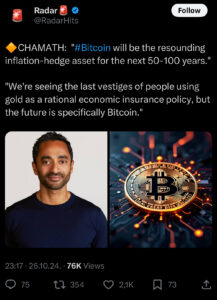Billionaire investor Chamath Palihapitiya recently made waves with his forecast on Bitcoin’s future in the global economy. In a post on X, he shared his belief that Bitcoin will eventually surpass gold as the go-to inflation hedge, predicting its ascent as the most vital asset for protecting wealth over the next 50 to 100 years. While gold remains the standard “economic insurance policy” for many, Palihapitiya believes that Bitcoin is primed to take on this role.

Why Bitcoin’s Scarcity is Key to Its Hedge Potential
Bitcoin’s design, with a fixed supply cap of 21 million coins, positions it as a formidable asset against inflation. This scarcity is reminiscent of gold’s limited supply, yet Bitcoin’s digital nature provides it with unique advantages. Unlike gold, which is challenging to transport and store, Bitcoin can be transferred instantly across borders, offering unprecedented accessibility and convenience.
The Growing Appeal of Bitcoin as a Modern Hedge
As economic instability and rising inflation concerns continue to trouble investors, many seek alternative assets beyond traditional options like gold. Bitcoin has become especially attractive to those wary of central banks and concerned about potential currency manipulation, further solidifying its appeal as an independent asset.

A Future Where Bitcoin Redefines Economic Insurance
Palihapitiya’s vision reflects the larger trend of decentralization and digital adoption in global finance. As Bitcoin gains mainstream acceptance and more countries adopt regulatory frameworks for digital assets, its resilience and independence could redefine what it means to hedge against inflation.
The Investment Landscape of the Next Century
If Bitcoin becomes the dominant inflation-hedging asset over the next century, it could revolutionize global finance by providing a modern form of economic insurance aligned with digital transformation. Investors looking to diversify and protect their wealth might find Palihapitiya’s forecast a compelling call to embrace Bitcoin as a valuable asset for the future.
